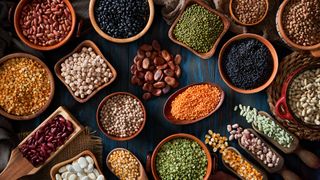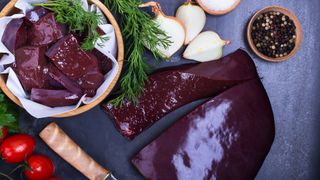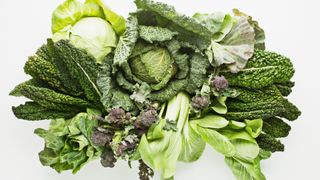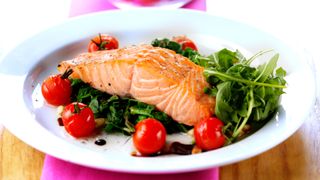Eight sources of iron to include in your diet
If you want to avoid feeling tired, making sure you include plenty of iron sources in your diet is very important. This is because iron is a vital mineral your body needs to make hemoglobin, a type of protein in red blood cells that carries oxygen from your lungs to the rest of your body. Without enough iron, we cannot make enough red blood cells to transport oxygen, leading to health problems and symptoms such as extreme fatigue.
Women are more prone to iron deficiency anemia due to blood loss during periods, and may want to consider supplements as a result. There are also some adjustments you can make to your diet to aid absorption, such as taking iron with vitamin C sources.
“Iron absorption is highly dependent on the health of the digestive tract,” adds Dr Margarita Kitova-John, a GP, functional medicine physician and founder Lantern Clinic (opens in a new tab). “It starts in the stomach and mostly occurs in the small intestine. Adequate secretion of hydrochloric acid in the stomach is essential for the initiation of the digestion of proteins and fats, as well as the activation of iron.
Dr. Jenny Williams, a general practitioner and principal clinical operations manager at Thriva (opens in a new tab), also adds: “Iron deficiency can lead to iron deficiency anemia, which can cause fatigue, heart palpitations, and shortness of breath. The good news is that you can give your body enough iron by eating the right foods.”
Here, the two experts give us their favorite iron-rich foods and explain why it’s so important that you eat enough. For healthy food inspiration, check out our easy Mediterranean diet meal plan or our 7 day plant-based diet meal plan.
1. Nuts and beans
Nuts and beans are great plant-based sources of iron that tend to be high in content too protein and other vitamins and minerals, making them a good base for eating. Canned and dried beans also have a long shelf life, so they can be a convenient and nutrient-dense option on a busy day when you don’t have anything at home.
“Toasted nuts are high in iron,” says Dr. Williams. “Like other nuts, they are a great source of iron and protein but contain less fat than meat. One can of 200 g of baked beans contains 2.8 mg of iron. That’s 19% of your daily iron if you’re a 30-year-old woman and 19% if you’re a man.
Kidney beans are very rich, containing 6.58 mg of iron per 100 g. Black beans contain 5.34 mg per 100 g, and pinto beans contain 5.4 mg.
“Red beans are great in chili con carne and soups and garbanzo bean flour can be used as a gluten-free flour,” adds Dr. Kitova-John.
2. Red meat
Red meat is perhaps the first thing people associate with iron, and it is a rich source of iron (the type of iron we get from animal sources that is easier for our bodies to digest).
Beef steak contains 3.5 mg of iron per 100 g, while lamb has 1.55 mg per 100 g. However, studies have shown that eating a lot of red meat is not very beneficial for our health Journal of Internal Medicine (opens in a new tab) suggests that reducing red meat consumption can help reduce the risk of cardiovascular disease and increase longevity.
“Red meat, like beef, is a good source of iron when eaten as part of a healthy diet,” says Dr Williams. “One 70 g serving contains 2.5 mg of iron. But you should avoid eating more than 350 g of red meat per week. Red meat, especially processed meats such as bacon and salami, is linked to bowel cancer. You should try to avoid eating processed meat altogether. Meat and fish contain heme iron, which your body absorbs more easily than iron in plant foods.”
3. Heart
While not to everyone’s taste, liver contains large amounts of heme iron, which makes it a great choice to supplement your diet if you have iron deficiency anemia. Goose liver can provide 30.5 mg per 100 g, chicken liver contains 8.99 mg and beef liver about 6.4 mg.
Dr Kitova-John explains that you don’t need to eat liver as a dish if you don’t want to, and liver can be added to other dishes. “Liver contains high amounts of iron. It can be eaten as a pate or frozen and grated as a powder in soups and stews.”
4. Dried fruit
Dried fruit can be an excellent source of iron and is also rich in vitamin C, making it a great choice to eat for easy absorption of iron.
“Dried fruit like raisins, apricots, figs and prunes are high in iron – just a little bit can increase your intake,” Dr Williams told LiveScience. “But dried fruit contains a lot of sugar, so try not to eat too much. One of your five-day servings is about 30 g or 1 tbsp. ”
5. Dark green vegetables
Dr. Williams tells us: “Dark green leafy vegetables like kale, spinach, and watercress are great sources of iron. Try adding it to food as an ingredient or side dish to increase the amount of iron you eat.”
Dark green vegetables are also a great source of vitamin C, as well as iron, which is needed for proper iron absorption. Although they themselves are not a source of iron-rich foods, dark green vegetables tend to be very nutrient-dense and their vitamin C content makes it easier for our bodies to absorb the iron they contain.
Dr Kitova-John mentions that as a vegetable source, spinach is a great choice for an iron-rich base, especially when combined with other iron sources.
“While usually described as the richest source of iron, spinach is actually a good source but not the best source. When compared to red meat, the ingredients are almost the same: 100 g of spinach contains 2.7 mg of iron versus the 2.6 mg found in 100 g of meat.
6. Eggs
Whole chicken eggs contain 1.67 mg of iron per 100 g and are nutritionally rich in other vitamins and minerals, making them a good choice for a snack or protein element of a meal, especially for vegetarians who may not want to eat other animal sources. of iron.
“They also contain protein, vitamin A, vitamin D, vitamin B12 and folate,” adds Dr. Williams. “Your body absorbs iron from animal products like meat and eggs more easily than from plant foods. So eggs are a useful way to increase your iron intake if you choose not to eat meat.”
7. Fish
Fish is a great source of lean protein and also provides important fatty acids that can help support brain health and function. They are also an excellent source of iron, with mackerel providing 1.63 mg of iron per 100 g, tuna 1.02 mg per 100 g and salmon providing 0.25 mg per 100 g.
Dr Williams explains that salmon is excellent because it is an oily fish, which means it contains a lot of other nutrients as well as iron. “Salmon is a good source of iron. So do other fish, such as shrimp, mackerel, haddock, and tuna. Salmon is also an oily fish. Oily fish are a good source of omega-3s, a family of fats that help keep your body healthy.
8. Nuts and Seeds
Nuts and seeds are great sources of iron, and are rich in protein and other nutrients. Cashews have 6.68 mg of iron per 100 g, pistachios have 3.92 mg per 100 g and pecans give us 2.53 mg per 100 g. You can also eat peanuts as peanut butter, which will make it easier to meet your daily iron needs.
“Nuts are rich in iron and protein,” explains Dr. Williams. “They also contain important vitamins and minerals like vitamin E and magnesium. Try to choose peanut butter that has a little added salt or sugar. Tree nuts are also high in iron, such as: hazelnuts, almonds, brazil nuts, cashews and pistachios.”
Whole grains are also great for snacking to increase iron. “Pumpkin seeds are rich in other vitamins and minerals, as well as iron,” says Dr. Kitova-John.
“Like nuts, whole grains are good sources of iron. They’re easy to add to foods you already eat, too — you can sprinkle them on foods like yogurt, smoothies, and salads. Or you can eat it as a snack. Just one tablespoon can increase your iron intake.”
#sources #iron #include #diet




Comments
Post a Comment